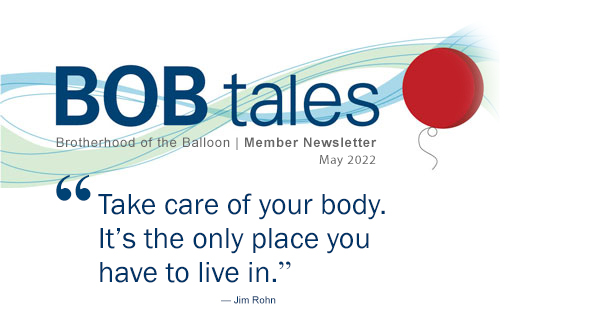
Dear Members (a note from Deb Hickey):
A brief email message from a newly diagnosed man put a smile on my face this morning. I wonder if he knew the power of his words.
-------------------
I spend about three hours each day responding to emails. Many of them are related to inquiries from men who’ve recently received the dreaded news that they have prostate cancer. Some emails come in from their significant others and some are written by their sons or daughters.
Every day, I answer questions and send information that I think will be helpful to these people. I take my time to answer every question as best I can.
I know from experience how devastating it can be to be diagnosed with “The Big C,” no matter what kind it is or the stage. The word “cancer” is probably the scariest word in the world. At least it is to me. My father had prostate cancer and my husband had Stage IV metastatic pancreatic cancer.
Not a day goes by when I don’t think about how life could have been.
So, when a newly diagnosed man writes to us, I automatically go into caregiver mode. I want to help. And if I think I’ve been helpful – even in a very small way – it literally changes my mood.
This morning I received an email from a gentleman who was recently diagnosed. He was doing his “homework;” had come across proton therapy online; and wanted more information.
Most, if not all, of these people have already read my father’s book and that’s how they find me. But if they don’t mention it, my first suggestion is always that they read it.
Since this gentleman didn’t mention the book, I told him a little bit about it and sent him a link to Amazon. I then suggested he speak with former proton patients about their experiences and outcomes (I suggested he speak with no fewer than 10 former patients representing every other treatment he was considering as well) and sent him a list of members. And I attached several articles and studies on proton therapy. I ended by letting him know he could write back if he had further questions.
His simple response warmed my heart because I knew I’d been helpful. And I knew he felt cared for. I also knew that I’d given him hope.
WOW! Thank you so much! This is a ton of incredibly valuable information I plan to study and digest. Thank you for taking the time and for helping me and relieving much of my anxiety. You are very kind.
I could tell by the capitalized “WOW!” that I’d exceeded his expectations and given him a little boost. And it was the “you are very kind” that made me really feel good. That’s all I ever want to be.
Although this may seem like a very small experience to share – it’s messages like this one that keep me going – the motivation I need to spend just a little more time responding to questions.
-------------------
This month, we share with you the latest on the transperineal biopsy – the alternative technique to the transrectal biopsy – and its rapid growth in acceptance in the U.S. and around the world. We also report on two studies that strongly support a plant-based diet for lowering risk of developing and dying from prostate cancer. In our Flashback section, a 15-year-old article linking obesity to severe prostate cancer still holds true today. And you’ll find our third comprehensive How Not to Die series – this time on diabetes – to be compelling.
As always, we love to get feedback on the newsletter, and welcome any suggestions you have on how to improve the value of the BOB Tales to our members. Just send an email to [email protected].
Deb Hickey
To print the BOB Tales newsletter or view the newsletter with a larger font size, click here for the PDF file. .jpg)
.jpg)
In This Issue:
- Moving Transperineal Prostate Biopsy into the Clinic
- Vegan Men Less Likely to Develop Prostate Cancer
- Milk and Prostate Cancer
- Obesity Linked to Prostate Cancer
- How Not to Die from Diabetes
Moving Transperineal Prostate Biopsy into the Clinic
In past BOB Tales newsletters, we’ve written about what we consider to be one of the weakest points in the prostate cancer diagnosis process – the transrectal ultrasound (TRUS) guided prostate biopsy. And, we reported on an exciting new development – a biopsy technique that virtually eliminates the probability of infection while giving the doctor better access to the entire prostate for tissue sampling.
For more than 30 years, the prostate biopsy procedure has remained relatively unchanged: an ultrasound probe is inserted into the rectum to image the prostate; a biopsy needle is then inserted into the rectum and the needle passes through the rectum into the prostate to remove tissue samples for examination under a microscope.
Since it’s impossible to sterilize the rectum, fecal material is often carried into the prostate when the tissue sample is taken. To mitigate the chance of infection, patients are typically given antibiotics. Nevertheless, infections occur 5 to 7 percent of the time depending on the practitioner, the medical center, and the individual patient’s response (or resistance) to antibiotics.
Infections seem to be occurring at an increasing rate, due to the increase in fluoroquinalone-resistant E coli found in the rectal flora of men. One to 3 percent of patients develop dangerous sepsis, often requiring hospitalization, and sometimes even causing death.
One alternative technique that has been used over the years that virtually eliminates the chance of infections is the trans perineal biopsy. With this procedure, the prostate is accessed through the perinium – the skin between the anus and the scrotum. This takes the rectum completely out of the picture.
But the problem with this technique is that it had to be done in a hospital setting, generally under anesthesia; it required multiple punctures of the perinium; and it’s time consuming and very costly.
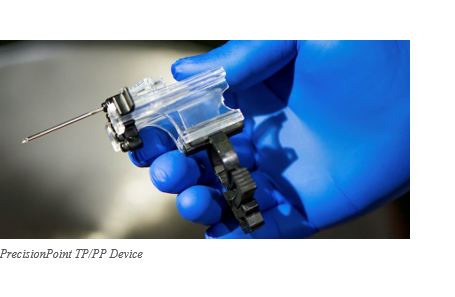 Dr. Matthew Alloway is a urologist and inventor of PrecisionPoint™, a new technique for conducting transperineal biopsies. A few years ago, he vowed that, because of the possibility of dangerous infection, he would never again biopsy a patient through the rectal wall. This incentivized him to develop this new Transperineal PrecisionPoint (TP/PP) technique.
Dr. Matthew Alloway is a urologist and inventor of PrecisionPoint™, a new technique for conducting transperineal biopsies. A few years ago, he vowed that, because of the possibility of dangerous infection, he would never again biopsy a patient through the rectal wall. This incentivized him to develop this new Transperineal PrecisionPoint (TP/PP) technique.
We wrote about PrecisionPoint in our May and June 2021 newsletters, and spoke to Dr. Alloway on several occasions. We’re very impressed with his knowledge and his commitment to helping patients.
Use Spreading Rapidly
The TP/PP technique is catching on, especially with premier urological and medical centers around the world. In a March 22, 2022 article in Urology Times entitled, “Moving Transperineal Prostate Biopsy into the Clinic,” the authors talk about the problems caused by the old transrectal biopsy technique as well as the challenges presented by early versions of the transperineal approach. They also discuss the new PrecisionPoint technology, and the benefits of this system, which allows full-prostate sampling using only two punctures, one for each prostate lobe. They further noted that this system has virtually eliminated prostate infections; it allows access to parts of the prostate previously inaccessible by TRUS biopsy; and contrary to previous transperineal approaches, it is much quicker and can be done in a clinic setting. The authors reported that, in addition to the significant reduction in infections and improved access to the prostate with this new approach, the learning curve for the TP/PP biopsy is short, which helps explain why it’s catching on so quickly.
We’ve learned that this new TP/PP transperineal biopsy system is rapidly growing in acceptance and use, and is routinely practiced in most of the UK as well as in Australia, New Zealand, Norway, and 10 other countries. The U.S. seems to be lagging behind somewhat, but many leading medical centers in the U.S. are using the new TP/PP prostate biopsy procedure and many others are evaluating this new technology.
Vegan Men Less Likely to Develop Prostate Cancer
A study that included data on 47,239 men found those under the age of 65 who had greater overall plant-based eating habits had a significantly lower risk of fatal prostate cancer.
Other research has shown that plant-based diets may also decrease mens’ risk of developing the disease. According to the American Institute for Cancer Research, a large U.S. study found that men following a vegan diet were 35 percent less likely to develop prostate cancer. This is consistent with the comprehensive article we presented in our March BOB Tales on “How Not To Die From Prostate Cancer” from Dr. Michael Greger’s epic book.
 More Benefits
More Benefits
Plant-based foods, such as cruciferous vegetables, allium vegetables, tomatoes, whole grains and green tea, also have anti-inflammatory and anti-oxidative effects, which may be helpful in supporting the overall health of men with prostate cancer.
Eating a diet consisting of significant amounts of red or processed meats and little poultry either before or after a prostate cancer diagnosis is associated with a higher risk of all-cause mortality, according to a 2020 study.
Plant-based diets also have the potential to treat comorbidities like diabetes, coronary artery disease, and hypertension.
Milk and Prostate Cancer
Research has indisputably linked dairy products to higher risk of prostate cancer. A 2013 study found those who consumed more than 2.5 servings of dairy products per day were 12 percent more likely to develop prostate cancer, compared with men who consumed less than half a serving. Men who drank more than one glass of whole milk per day had double the risk for fatal prostate cancer, compared with men drinking less.
A 2015 meta-analysis, in which researchers analyzed data from 32 studies, found high consumption of dairy products increases the risk for prostate cancer.
Whole milk consumption also increases risk for prostate cancer recurrence in overweight and obese men, according to a 2018 study. Men who consumed more than four servings of whole milk per week had a 73 percent increased risk for recurrence compared to men who consumed fewer or no servings of milk.
Dairy products also increase the risk of death from prostate cancer, according to another 2015 study. Men who consumed three or more servings of dairy products a day had a 141 percent higher risk of death due to prostate cancer compared to those who consumed less than one serving. Both high- and low-fat dairy products were associated with increased mortality.
A more recent study found the odds of prostate cancer risk were 1.5 times in men who consumed whole milk as compared to men who consumed 2 percent milk or skim milk. And men who consumed whole milk had a higher risk associated with recurrence of their cancer.
In our March BOB Tales How Not to Die segment, we told you about laboratory experiments that showed cow’s milk stimulated growth of prostate cancer in a petri dish, while almond milk, for example, suppressed prostate cancer growth. Also, other studies documented in Dr. Greger’s How Not to Die book showed that high intakes of dairy products like milk (including low-fat milk) and cheese appeared to increase prostate cancer risk. And interestingly, these findings didn’t show up with consumption of yogurt and soured milk. This could be due to the presence of bacteria in these foods.
We’ve been producing BOB Tales newsletters for more than 20 years. During this time there have been articles that many new members haven’t seen, and some older members may have forgotten. So, we periodically re-run articles from past newsletters. The following is from more than 15 years ago, December 2006.
Obesity Linked to Severe Prostate Cancer
The Seattle Post Intelligencer reported on a study, which indicates the heavier you are, the worse the disease. Researchers at Fred Hutchinson Cancer Research Center found excess weight is associated with an 80 percent increase in the risk of high-grade, or aggressive, prostate cancer. They published the results of their study in the October 2006 issue of Cancer Epidemiology, Biomarkers and Prevention. The study was funded by the National Cancer Institute.
Apple-shaped men, according to the study, store fat in the abdominal area and have double the risk of both low- and high-grade prostate cancer. The article states, “The findings mean the more you weigh, the more aggressive the prostate cancer will be once it's diagnosed, which also explains why obese men are more likely to get the type of prostate cancer that is fatal.”
Other recent articles on prostate cancer research have reported that losing weight might help prevent prostate cancer or help prevent a recurrence of the disease after treatment.

Proton Research Programs Benefitting from Contributions
Bob Marckini had a recent conversation with Dr. Jerry Slater, Chairman of the Department of Radiation Medicine at Loma Linda University Cancer Center. During the discussion, Dr. Slater shared much information about proton research programs that are benefiting from contributions coming in from BOB members to the Dr. James Slater Chair and the Robert J. Marckini Chair. In addition to the massive COMPPARE clinical trial, these research efforts cover numerous disease sites including esophagus, liver, liver metastasis, advanced breast cancer, pediatric cancers, head and neck cancers, nasopharynx cancers, advanced lung cancer, ocular melanomas and others. We learned during this conversation that Loma Linda has a dedicated treatment line for treating ocular melanomas.
Each month Bob and Deb attempt to contact by phone members who have made gifts in the recent past to thank them for their contributions and to find out how they’re doing, sometimes many years after treatment. We generally manage to reach about half of them. It’s always good to connect with our members. So many tell us how well they’re doing and how much they enjoy reading the BOB Tales newsletter each month. Many make gifts every month, and some once a year. Several have told us they are remembering Loma Linda in their estate plan as Bob and Deb are doing. Nothing makes us happier.
Don't Just Stand There
In an effort to boost funding for basic and clinical proton therapy research on prostate cancer, pancreatic cancer, liver cancer, breast cancer, and more, we asked our members to donate $100 (or more) to Loma Linda University Cancer Center. In return, they’d receive an advance copy of Dr. William Preston’s book, Don’t Just Stand There – Realizing a Vision for Proton Therapy: Conversations with James M. Slater, MD, FACR. The response so far has been phenomenal. Thank you to all who’ve requested a copy.
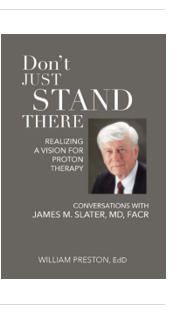 If you’d like a pre-published copy of “Don’t Just Stand There,” please send a check for $100 or more, payable to “Loma Linda University Proton Cancer Research” and mail it to:
If you’d like a pre-published copy of “Don’t Just Stand There,” please send a check for $100 or more, payable to “Loma Linda University Proton Cancer Research” and mail it to:
Loma Linda University Health ● Office of Philanthropy ● PO Box 2000 ● Loma Linda, CA 92354
Please notify Deb Hickey at [email protected] that you’ve sent in your check and your book will be mailed immediately.
Don’t Just Stand There, a book with high-quality color images and illustrations, is not just about Dr. Slater’s quest to create the world’s first hospital-based proton treatment center. It's also a teaching guide. As the Proton Treatment & Research Center at Loma Linda was such an immense endeavor, Dr. Slater wondered if the aspects of conceiving, planning, and orchestrating such a project, among others he undertook, might be instructive to others. Over the years, he’d also met people in all walks of life, many of whom had dealt with large and complex problems. He was struck by some of the stories they told about their work. And although the fields or disciplines usually had nothing to do with medicine, many experiences were similar. And so, he kept this in mind while he worked on the book with Dr. Preston.
We’re sure you’ll thoroughly enjoy the book and we know it will occupy a place of honor
in your home. And, you’ll be helping to fund basic and clinical proton research on prostate cancer, pancreatic cancer, liver cancer, breast cancer, and much more with your tax-deductible gift. Thank you!
Giving Options
- Donate to proton research online.
- Write a check to LLUCC Proton (Put “Marckini Chair” on the memo line) and mail to LLUH, Office of Philanthropy P.O. Box 2000, Loma Linda, CA 92354.
- Make an unrestricted gift (put “unrestricted” on memo line) so LLUH can use it where it’s needed most.
- Call Regina Joseph at 909-558-5010 to donate over the phone.
.jpg)
.jpg)
How Not to Die from Diabetes
By Bob Marckini
In our March BOB Tales we told you about an important new book, How Not to Die, that was brought to our attention by our good friend, BOB member Charles Smithgall. “The book changed my life,” Charles said.
The author, Michael Greger, MD, is the founder of Nutritionfacts.org, a science-based nonprofit that follows and reports on the latest in nutrition research. In his book, Dr. Greger addresses the 15 leading causes of premature death that take the lives of 1.6 million Americans annually. And he says, “This doesn’t have to happen.”
By reading Dr. Greger’s book, which is backed-up by a mountain of documented scientific evidence, you can learn about diet and lifestyle choices that can literally help you slow, stop, and even reverse many diseases to live a longer and happier life.
In our March issue we reported on “How Not to Die from Prostate Cancer.” Last month we covered the No. 1 killer in the U.S., “How Not to Die from Heart Disease.” This month we’re addressing another serious disease, often referred to as an epidemic: “How Not to Die from Diabetes.”
Diabetes an Epidemic
Twenty-five million Americans suffer from diabetes and the effects of this epidemic are alarming. The most serious diabetes effects are kidney failure (50,000 cases/year), amputations (75,000/year), vision loss (650,000 cases/year) and premature death 75,000/year).
The CDC reports that 37 percent of U.S. adults, which includes 51 percent of adults over 65, have prediabetes, that’s 86 million people. So, more than a third of our population is either diabetic or prediabetic.
What is Diabetes?
Diabetes generally refers to chronically high levels of sugar in your blood. There are two types of diabetes.
Type 1 diabetes refers to a condition where your pancreas doesn’t make enough insulin, the hormone that keeps your blood sugar in check. Type 1 diabetes is sometimes called juvenile-onset diabetes and represents about 5 percent of diabetes cases reported.
Type 2 diabetes, which is significantly more prevalent, has been referred to as “The Black Death of the 21st Century,” because of its rapid growth (tripling since 1990). People with Type 2 diabetes have a functioning pancreas, but because of the accumulation of saturated fat, the body resists the insulin it produces. This type of diabetes is generally characterized by insulin resistance in your muscles, caused mostly by poor dietary choices.
Ingested carbohydrates are broken down into simple sugar, called glucose. This sugar/glucose powers all the cells in your body. It’s the insulin released by the pancreas into your blood that regulates the flow of sugar into those cells. Without insulin, sugar builds up in your blood and causes serious health problems including neuropathy, kidney failure, heart attacks and stroke.
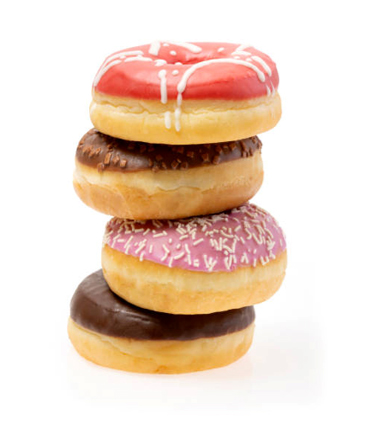 The Diet Factor
The Diet Factor
In one early study, people who were given a fat-rich diet including butter, egg yolks, cream, etc., while another group consumed a diet rich in carbohydrates, such as candy, pastry, white bread, potatoes, bananas, oatmeal, etc. Insulin resistance shot up in the fat-rich diet group as did blood sugar levels. Additional research showed researchers that the fat (intramyocellular lipid) inside the muscles was stopping the insulin from sending glucose into the muscles. This fat comes primarily from diet. Fat clearly damages the body’s ability to process sugar. So, reducing dietary fat can help the insulin in your body do a better job channeling sugar into muscles and cells. More and more children are being diagnosed with Type 2 diabetes as a result of their often fat-rich diets which result in obesity and insulin resistance. And sadly, the damage begins even during the prediabetic stage as kidneys, eyes, blood vessels and nerves can be affected.
A study at Loma Linda University in 2010 showed that giving up meat is an effective way of combating child- hood obesity. Other studies at Loma Linda showed that people who ate plant-based diets are generally thinner than those who regularly consumed meat.
Body Mass Index BMI
A BMI between 18.5 and 25 is considered “normal.” A BMI between 25 and 30 is considered overweight. And those with a BMI over 30 are considered obese.
A large North American study compared the obesity rates of people with different diets. Meat eaters scored the worst with an average BMI of 28.8. Next came flexitarians (meat eaten weekly, not daily) at 27.3; next were pesco-vegetarians (fish eaters) at 26.3; followed by vegetarians at 25.7; and finally, vegans with an average BMI at 23.6. Clearly there’s something to be said about the value of a whole-foods plant-based diet.
To calculate your Body Mass Index, multiply your weight in pounds by 703, then divide it by your height in inches squared. So, if you weigh 190 pounds and you’re 5-foot-9-inchestall (69 inches), your BMI is 190x703÷(69x69) =28.0, and you are overweight.
It’s All about the Fat
The author, Dr. Greger, tells us that excess body fat is the No. 1 risk for Type 2 diabetes. The fat in our body spills into our bloodstream clogging insulin signaling, creating insulin resistance, which is the cause of Type 2 diabetes.
Multiple studies have shown that reducing dietary fat reduces insulin resistance. But animal fats and plant fats are very different. Saturated fats found in meat and dairy products can cause insulin resistance. Surprisingly, fats found in plant foods have been found to actually protect against animal food saturated fats. Clearly, eating a plant-based diet better protects you from diabetes.
Studies have shown that people who switch to a plant-based diet tend to lose weight even without paying attention to portion control. The effect of this diet is usually weight loss, improved blood sugar control and reduced risk of cardiovascular disease.
Another benefit of a plant-based diet is reduced levels of LDL (bad)
cholesterol.
 But Is a Plant-Based Diet Healthful?
But Is a Plant-Based Diet Healthful?
A study involving 13,000 people examined nutrient intake of both meat eaters and vegetarians. Surprisingly, vegetarians scored higher in essentially every nutrient including fiber, vitamin A, C, E, and B, as well as calcium, magnesium, iron, and potassium. Also, the vegetarian group consumed close to 400 fewer calories per day than the meat-eating group without restricting the quantity of food they ate.
The resting metabolic rate in the vegetarian group was markedly higher as well, which translates into burning more calories, even while resting, than the meat-eating group.
Can Diabetes Be Reversed? If So, How?
Dr. Greger talks about a large study, reported in The New England Journal of Medicine, involving 10,000 diabetics who were split into two groups. For one group, the goal was to reduce blood sugar. In the other group, an aggressive program was initiated involving multiple classes of oral medications with and without insulin with the same objective, i.e. to drive down blood sugar levels.
The result of this study surprised almost everyone. Those who were in the aggressive program actually had an increased mortality rate forcing researchers to shut down the program. In addition to increased mortality, patients were experiencing accelerating aging vision loss, and an increase in cancers and other diseases. By artificially driving down blood sugar levels in both groups, they weren’t solving the problem, they were exacerbating it.
Researchers discovered that the best results were achieved by changing patients’ diets, which worked even better than gastric bypass surgery in controlling diabetes. Blood sugar levels can normalize very quickly when following a low-calorie diet, and the risks of major surgery are avoided.
But the best results in reversing diabetes were achieved by focusing on changing the quality of food you eat, not the quantity. One study had participants eating essentially all they wanted of a plant-based diet including vegetables, beans, whole grains, fruits, nuts, and seeds. The improvements in subjects’ diabetes markers were remarkable, with hemoglobin A1c levels dropping into the normal range in just a few months. Even the patients who didn’t lose much weight on this diet saw improvement in their blood sugar and thus diabetes levels. Other studies over the years have produced similar results with blood sugar levels dropping and the need for insulin injections eliminated.
Researchers concluded that it made more sense to eliminate the root causes of insulin resistance. Several examples were given in this chapter where subjects who changed to plant-based diets were able to significantly reduce and in many cases, eliminate their need for insulin to control their diabetes.
What About Neuropathy?
Dr. Greger points out that about 50 percent of diabetics suffer from neuropathy, which can be very painful. For years doctors have been treating patients with steroids, opioids and antidepressants for neuropathy. Once again plants to the rescue! A study entitled, “Regression of Diabetic Neuropathy with Total Vegetarian (Vegan) Diet,” showed that patients placed on a plant-based diet experienced relief from pain within days of starting the diet. Many suffered from debilitating pain for years. Additionally, the subjects lost weight, blood sugar levels fell, as did triglyceride, cholesterol and blood pressure levels and . . . insulin dependence. Dr. Greger commented, “We’ve long known that plant-based diets can reverse diabetes and hypertension, but reversing nerve damage pain with diet was new.” Greger is baffled that this isn’t front-page news.
In Summary
There is much more in this important chapter on how not to die from diabetes. To sum it up, let me relay a story Dr. Greger told about a 65-year-old American Indian with diabetes. This patient had been on insulin for almost 30 years and was suffering some of the worst symptoms of the disease. His doctor had told him that American Indians are genetically predisposed to diabetes, and that he’d have to learn to live with it. This subject’s granddaughter persuaded him to try a plant-based diet, which he did, and the results were astounding. His diabetic symptoms disappeared, including his neuropathy, and he no longer needed insulin. He reports feeling better than he has in years. “I feel young again,” he says.
Dr. Greger’s research and reporting is compelling. We have so much more control of our health than we realize. And there are concrete steps we can all take to slow, stop and even reverse diseases that are killing millions of people every year.

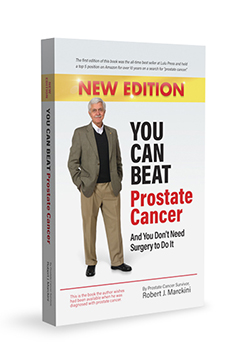 You Can Beat Prostate Cancer: And You Don’t Need Surgery to Do It –Second Edition
You Can Beat Prostate Cancer: And You Don’t Need Surgery to Do It –Second Edition
Audiobook Launched
Last month we reported that the audio version of Bob’s second edition book – narrated by Bob – has been launched. It’s available for purchase from Amazon, the Apple iBook store and through iTunes.
This month we negotiated an agreement with Findaway Voices, a new audiobook outlet that has 40 audiobook distributors in their network including Walmart, Barnes & Noble and Nook. So, the audio version is out there and, hopefully will reach a new audience of men and their loved ones who are dealing with, or are at risk for prostate cancer.
We’ve begun receiving feedback from men who only “read” their books via audio format. They have thanked us for producing the audio version, and are listening to it.
Several members told us they enjoyed listening to the short audio link we provided last month. If you click here, you can listen to a different five-minute sample of Bob’s audiobook. It’s amazing what a different perspective you can gain listening to the book. We’re excited that the complete audiobook is available, and we’ll share listeners’ feedback in future BOB Tales. If you’ve already read the book, you may want to listen to the audio version as well. Believe it or not, Bob’s listened to it twice already, and he says “it’s fantastic!” We think he likes listening to his own voice.
Latest Amazon Review
“A Treasure Trove of Information”
A Calming Place in the Storm of Prostate Cancer Diagnosis
Imagine you’ve just been given the news that your great health has been ended by a diagnosis of aggressive prostate cancer! How much do we know about our own body? As a post graduate engineer the answer is: not much! Your urologist says we will schedule an appointment with Dr. Joe X across the street. I am an older soul or I am quite certain he would have said: I am a good surgeon and we can take that bad boy out the week after next.
Lucky for me, my wife, a retired midwife of many years, calmed me down and suggested I get another opinion.
I check out Dr. Joe X; he’s a radiation oncologist who specializes in several cancers, but not prostate! I have a couple of friends who’ve had recent bouts with cancer. One had radiation treatments that physically burned him to what he called ‘third-degree’ burns and cured his cancer, but left him in several years of recovery from side effects.
The other friend described a two-month vacation treatment in Jacksonville, FL (coincidently my home town). I called him and he described his proton therapy and the 30 minutes-a-day, non-invasive treatment with no adverse effects then, since, or expected in the future.
He’d read this book and another more comical book by Ron Nelson, and offered to send them to me. I thanked him and received my own copy.
This book is the lay textbook for those diagnosed with prostate cancer!
My lessons learned are to not blindly trust your urologist; and do your own due diligence! This book is a treasure trove of information to start your journey.
For me and the author, this lead to proton therapy treatment. You may choose a different treatment described in this book. In my journey, my PSA went from 13.2 to less that 0.1 (undetectable by the lab I used) one week following my 41 treatments.
If you or someone you know has a prostate cancer diagnosis, get them this book!
Step 7 in the 10 Steps
In October we began reviewing, what we consider to be, the most important chapter in Bob’s second edition book, Chapter 18, entitled, “Ten Steps for Taking Control of the Detection and Treatment of Your Prostate Cancer.” To date, we’ve covered the first six steps. Following is step 7.
Talk with Men Who Have Been Through Each Option You Are Considering
Prostate cancer is slow growing. It took years for it to grow to the point where it was detected in your body. In most cases, you don’t have to make a treatment decision today, this week, or even this month. Take the time to do your research. Buy and read the best books on the subject. Research the Internet. And, above all, talk with several men who have had each of the treatments you’re considering.
Remember, most books on this subject are written by doctors or researchers who haven’t been through the treatment. Only someone who’s been through it can truly relate to you his personal experience. Make up your own list of questions for these former patients representing each treatment option.
Include questions such as the following:
Why did you choose surgery (or brachytherapy, or external beam radiation etc.)? Did you do extensive research? Or did you just accept your urologist’s recommendation?
Did you consider any other treatment option? If so, why did you disregard them?
What was your experience of the treatment you chose? Was it positive? Was there any pain, blood loss, or complications?
What short-term side effects did you experience? How long did they last?
What long-term side effects have you experienced?
Ask specific questions about incontinence. Did you experience any incontinence? Bladder control problems? Do you have any leakage today? If so, under what conditions?
Ask specific questions about impotence. Have you experienced any changes in sexual function? Are erections the same today as they were before treatment?
When did you have this procedure done? What was your pretreatment PSA, Gleason score, and T-score? What’s your PSA today? (Remember, if he had surgery and the prostate was removed, his PSA should be non-detectable. If he had any other procedure, he still has a prostate, and there is most likely a low level of measurable PSA. It should be dropping or holding steady, if he’s reached nadir.)
Would you choose this procedure again? This will tell you a lot about this patient’s overall evaluation of the option he chose. Several of the men I talked with told me they felt they made the wrong choice.
What advice do you have for me? We can always learn from another patient’s experience. If he chose the same treatment option you’re considering, perhaps he can tell you about ways to prepare for your treatment or give you ideas that will make your experience less anxiety filled and even enjoyable. I received numerous helpful suggestions and recommendations from former proton patients.
Can you give me the names and phone numbers of others who have had prostate cancer treatment? You can never talk with too many former patients. You’ll learn more from them than from doctors, books, or the Internet, especially if you question them in depth.
Next month we’ll review Step 8: Make Your Decision Based on What is Best for YOU
Did you find Bob’s new book helpful?
Please write a review on Amazon! The more reviews, the more likely a user will purchase a product. Every single review contributes to the visibility of this book.
Note: We are happy to deeply discount books in quantity to anyone who is interested in spreading the word on proton therapy. Just send an email to [email protected].
Proceeds from book sales are used to help fund our efforts and to support proton therapy research.



Last Month’s Brain Teaser
This one’s for the engineers and scientists in our group …
The moon is about a quarter million miles from Earth. If a large meteor crashed into the moon, how long would it take for the sound of the explosion to reach the Earth?
Answer: The sound would never reach the earth as sound cannot travel in a vacuum.
Winner: Nearly everyone answered correctly! The winner is BOB member Grady Burrow from Mountain Brook, AL and his signed copy of Bob’s book is on the way!
.jpg)
.jpg)
New Brain Teaser
Here’s another one for the engineers and scientists in our group …
You have a helium-filled balloon (lighter than air) in your car and all the windows closed. As you turn a corner, which way does the helium balloon move?
Send your brain teaser answer to [email protected] for a chance to win a signed copy of Bob Marckini’s NEW second edition book, You Can Beat Prostate Cancer.
Sharing is Caring
A little old couple walked into McDonald’s one evening. They looked out of place amid the young families eating there. Some customers looked admiringly at them. They’d clearly been through a lot together – probably for 60 years or more!
The little old man walked up to the cash register and placed an order. After paying, the two took a table near the back of the restaurant and started taking food off the tray. There was one hamburger, one small order of French fries, and one small soda.
The little old man unwrapped the plain hamburger and carefully cut it in half. He placed one half in front of his wife. He then carefully counted the French fries; divided them into two piles, and neatly placed one pile in front of his wife. He took a sip of the drink, and then his wife took a sip before setting the cup down between them.
As the man began to take a few bites of the hamburger, some of the other customers began to feel uneasy. That poor couple, they thought. All they can afford is one meal for the two of them!
As the man began to eat his French fries, one young man stood and walked over to the old couple’s table. He politely offered to buy another meal for the couple to eat. The old man replied that they were just fine; they were used to sharing everything.
Then the onlookers noticed that the little old lady hadn’t eaten a bite. She just sat there watching her husband eat and occasionally took sips of the soda. Again, the young man walked over and begged them to let him buy them another meal.
This time the lady explained that no, they were used to sharing everything together.
As the little old man finished eating and was wiping his face neatly with a napkin, the young man could stand it no longer. He got up again and walked over to their table. He offered to buy them another burger.
After being politely refused again, he finally asked a question of the little old lady. “Ma’am, why aren’t you eating? You said you share everything. What is it that you are waiting for?”
She answered, “The teeth.”
Answering Machine Message
“I am not available right now but thank you for caring enough to call. I am making some changes in my life. Please leave a message after the beep. If I do not return your call, you are one of the changes.”
 Little Old Lady
Little Old Lady
A young man shopping in a supermarket noticed a little old lady following him around. If he stopped, she stopped. She also kept staring at him.
She finally overtook him at the checkout counter and said, “I hope I haven’t made you feel ill at ease … it’s just that you look so much like my late son.”
He answered, “That’s okay.”
The old lady said, “I know it’s silly, but if you’d call out, ‘Goodbye, Mom’ as I leave the store, it would make me so happy!”
She then went through the checkout; and as she was on her way out of the store, the man called out, “Goodbye, Mom!” The little old lady waved and smiled warmly back at him.
Pleased that he’d brought a little sunshine into someone’s day, he went to pay for his groceries.
“That comes to $221.85,” said the clerk.
“How come so much?! I bought only toilet paper!”
The clerk replied, “Yeah, but your mother said you’d be paying for her things, too.”
![]()


Boy Were They Wrong — Part III (Source)
Airplanes are interesting toys, but of no military value. ─Marshal Ferdinand Foch, French military strategist, 1911. He was later a World War I commander
There is not in sight any source of energy that would be a fair start toward that which would be necessary to get us beyond the gravitative control of the earth. ─Forest Ray Moulton (1872-1952), astronomer, 1935
This “telephone” has too many shortcomings to be seriously considered as a practical form of communication. The device is inherently of no value to us. ─Western Union internal memo, 1878
Did You Know? (Source)
Glass takes one million years to decompose, which means it essentially never wears out and can be recycled an infinite number of times!
Gold is the only metal that doesn’t rust – even if it’s buried in the ground for thousands of years.
Your tongue is the only muscle in your body that’s attached at only one end.
If you stop getting thirsty you need to drink more water. When a human body is dehydrated, its thirst mechanism shuts off.
Zero is the only number that can’t be represented by Roman numerals.
Kites were used in the American Civil War to deliver letters and newspapers.
Nine out of every 10 living things lives in the ocean.
.jpg)
.jpg)
Quote of the Month:
“If you keep doing what you've always done, you'll keep getting what you've always gotten.” – Unknown



A List to Live By (Source)
| Most Destructive Habit | Worry |
| Greatest Joy | Giving |
| Greatest Loss | Self-Respect |
| Greatest Natural Resource | Our Youth |
| Greatest Shot in the Arm | Encouragement |
| Greatest Problem to Overcome | Fear |
| Ugliest Personality Trait | Selfishness |
| Most Satisfying Work | Helping Others |
| Most Endangered Species | Dedicated Leaders |
| Most Effective Sleeping Pill | Peace of Mind |
| Most Crippling Failure | Excuses |
| Most Powerful Force in Life | Love |
| Most Dangerous Outcast | One Who Gossips |
| The World’s Greatest Computer | The Brain |
| Worst Thing to be Without | Hope |
| Two Most Powerful Words | “I Can” |
| Greatest Asset | Faith |
| Most Worthless Emotion | Self-Pity |
| Most Beautiful Attire | A Smile |
| Most Prized Possession | Integrity |
| Most Effective Communication | Prayer |
| Most Contagious Spirit | Enthusiasm |
Low PSAs to all,
Bob Marckini and Deb Hickey
To print the BOB Tales newsletter or view the newsletter with a larger font size, click here for the PDF file.
NO MEDICAL ADVICE: Material appearing here represents opinions offered by non-medically-trained laypersons. Comments shown here should NEVER be interpreted as specific medical advice and must be used only as background information when consulting with a qualified medical professional.


.jpg)
.jpg)

